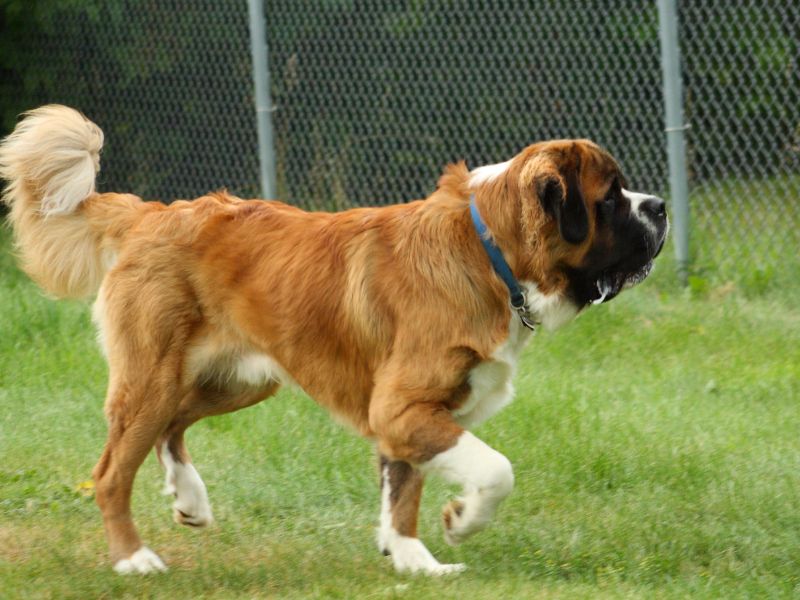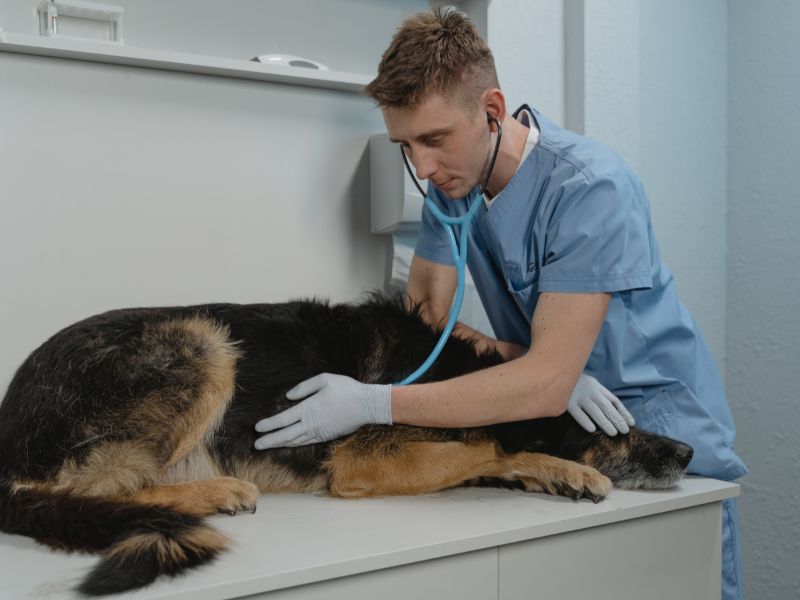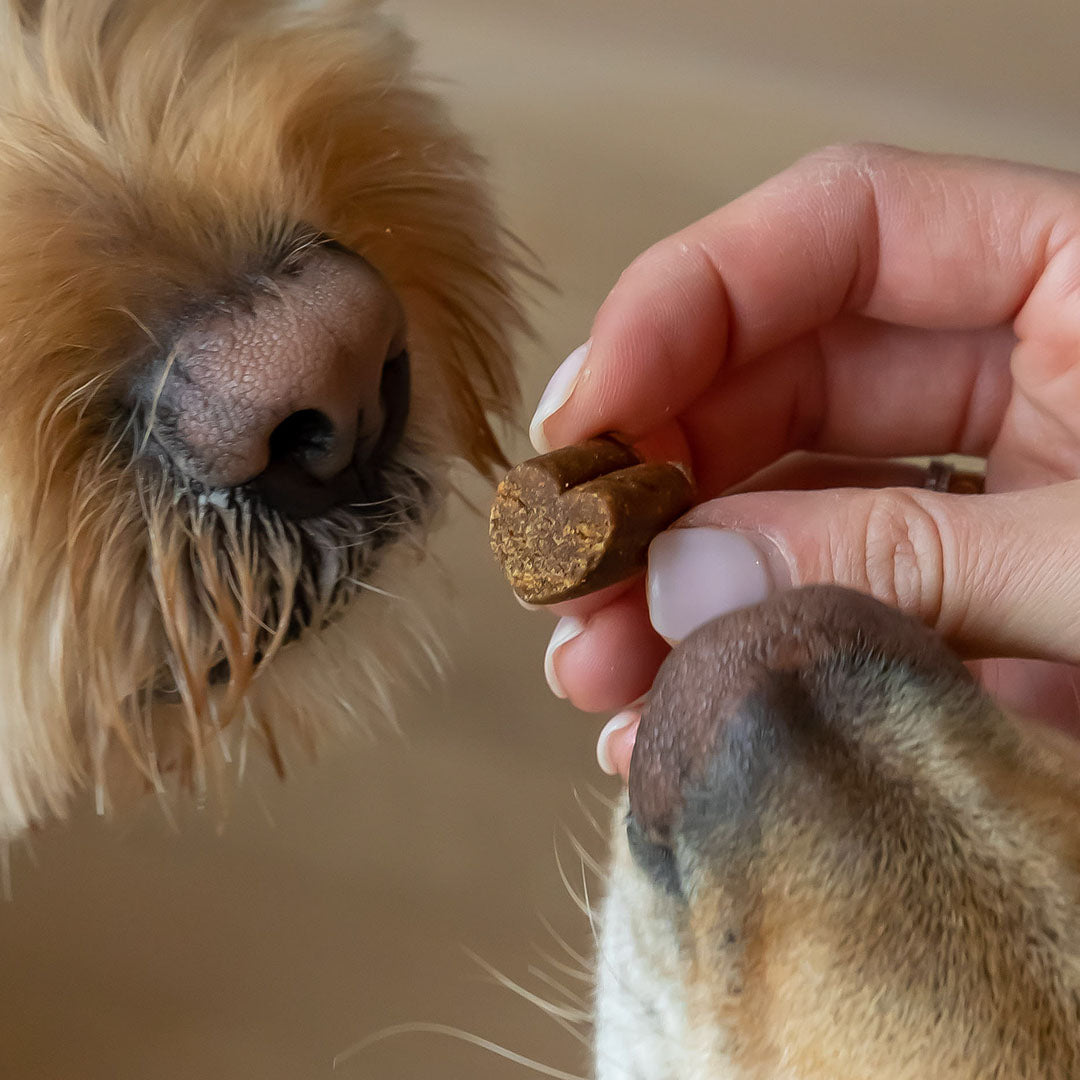Comparing Dog Years to Human Years
Ever wondered how old your furry friend is in human years? The answer isn’t as simple as multiplying by seven. While the 7-year rule has been a popular myth, science suggests more accurate ways to convert dog years to human years based on factors like breed size and aging rates.

To calculate dog years to human years, enter your dog's age and breed and press Submit.
How Do You Calculate Dog Years to Human Years? 3 Methods
There are three primary methods used to determine your dog's true age:
1. The Breed Size Strategy
Age calculation is based on breed size factors.
2. The Logarithmic Approach
A scientifically-backed formula for precise age conversion.
3. The 7-Year Rule
A widely known but debated method.
Let's break down each approach to help you understand your dog’s human age.

Breed Differential Strategy: Human-equivalent Age by Size
When it comes to dog years to human years, breed size plays a major role in aging. Unlike the 7-year rule, which treats all dogs the same, science tells us that small dogs tend to live much longer than large dogs due to differences in cellular aging, oxidative stress, and methylation rates.
Let’s explain why size impacts lifespan and how you can accurately determine your dog’s age.

Why Do Small Dogs Live Longer Than Large Dogs?
Smaller dogs, like Chihuahuas and Dachshunds, often live 14–18 years, while larger breeds, like Great Danes and Mastiffs, typically live 6–10 years. But why?
The answer lies in biological aging mechanisms such as methylation, oxidative stress, and growth factor regulation.

1. What is Methylation: The Epigenetic Clock of Aging
Methylation is a biological process that affects gene expression. Think of it as an aging clock for DNA.
- Dogs and humans have methylation markers that determine how fast their cells age.
- Scientists have found that large breeds accumulate DNA methylation changes faster than small breeds.
- This means a 2-year-old Great Dane is biologically older than a 2-year-old Beagle, even though they were born at the same time.
🔬 Scientific Insight: Research from the University of California San Diego confirmed that dog aging is not linear but accelerates with age, especially in large breeds.

2. Oxidative Stress & Cell Damage
Another key factor in dog lifespan is oxidative stress, which refers to damage from free radicals at the cellular level.
- Large dogs grow faster, meaning their cells divide more frequently, leading to more cellular wear and tear.
- This rapid growth results in a higher risk of age-related diseases, including cancer, arthritis, and heart disease.
🧬 Fast Fact: Studies show that larger dogs reach senior status much earlier because their bodies experience greater metabolic stress over a shorter period.

3. Growth Factors & Lifespan
Growth hormones influence both size and aging. Large dogs produce more IGF-1 (Insulin-like Growth Factor 1), a hormone that accelerates growth and shortens lifespan.
- High IGF-1 levels are linked to shorter lifespans in mammals, including humans.
- Small dogs have lower IGF-1 levels, which slows aging and allows them to live longer.
💡 Key Takeaway: The same hormones that make large dogs grow fast also contribute to faster aging and a shorter lifespan.
How to Calculate Dog Years to Human Years Based on Breed Size: An Easy Chart
Scientists use breed-specific aging rates rather than a one-size-fits-all formula to accurately determine a dog’s age in human years.
Here’s a quick table of dog years to human years for small, medium, and large breeds:
| Dog Age | Small Breeds (Under 20 lbs) | Medium Breeds (20-50 lbs) | Large Breeds (50+ lbs) |
|---|---|---|---|
| 1 year | 15 years | 15 years | 14 years |
| 2 years | 24 years | 24 years | 22 years |
| 3 years | 28 years | 28 years | 28 years |
| 4 years | 32 years | 32 years | 34 years |
| 5 years | 36 years | 36 years | 40 years |
| 6 years | 40 years | 42 years | 45 years |
| 7 years | 44 years | 47 years | 50 years |
| 8 years | 48 years | 51 years | 55 years |
| 9 years | 52 years | 56 years | 61 years |
| 10 years | 56 years | 60 years | 66 years |
| 11 years | 60 years | 65 years | 72 years |
| 12 years | 64 years | 69 years | 77 years |
| 13 years | 68 years | 74 years | 82 years |
| 14 years | 72 years | 78 years | 88 years |
| 15 years | 76 years | 83 years | 94 years |
| 16 years | 80 years | 87 years | 99 years |
| 17 years | 84 years | 92 years | 105 years |
| 18 years | 88 years | 96 years | 111 years |
| 19 years | 92 years | 101 years | 118 years |
| 20 years | 96 years | 105 years | 125 years |
📌 What This Chart Means:
- A 10-year-old German Shepherd is like a 66-year-old human, while a 10-year-old Chihuahua is only 56 human years old.
- The aging curve accelerates in large breeds, making them age faster after year 5.
- Breed size matters—your dog’s true age in human years depends on whether they’re small, medium, or large.
For more personalized results by breed size, try our interactive Dog Age Calculator
The Logarithmic Approach
Recent research suggests that dog aging isn’t linear. Instead of a simple 1:7 ratio, scientists at the University of California San Diego developed a logarithmic formula to convert dog years to human years more precisely:
Human Age=16×ln(Dog Age)+31
Here’s how it works with real examples:
Example 1: How Old Is a 2-Year-Old Dog in Human Years?
Example 1: How Old Is a 2-Year-Old Dog in Human Years?
Using the formula: 16×ln(2)+31 = 16×0.693+31 = 11.1 + 31 = 42.1 human years A 2-year-old dog is roughly 42 human years old—much older than the traditional 7-year rule suggests!
Example 2: How Many Human Years Is a 5-Year-Old Dog?
Example 2: How Many Human Years Is a 5-Year-Old Dog?
Using the logarithmic equation for dog years to human years: 16×ln(5)+31 = 16×1.609+31 = 25.7+31 = 56.7 human years A 5-year-old dog is approximately 57 human years old.
Example 3: How Old Is a 13-Year-Old Dog in Human Years?
Example 3: How Old Is a 13-Year-Old Dog in Human Years?
According to the logarithmic model: 16×ln(13)+31 = 16×2.564+31 = 41.0+31 = 72 human years A 13-year-old dog is roughly 72 human years old, which aligns with how senior dogs show signs of aging, like mobility issues and cognitive changes. Here is a link to the Natural Logarithm Calculator to try for yourself
Logarithmic Way:
What is your dog's age?
To calculate dog years to human years, select your dog's age using the slider and press Submit to get the calculation.
Your Dog's Age in Human Years: 0

The 7-Year Rule: Myth or Valid?
For decades, people believed that one dog year equaled seven human years. While this method is simple, it's not scientifically accurate.
Why the 7-Year Rule Is Misleading:
- Dogs age rapidly in their first two years.
- Small breeds live longer than large breeds.
- A 1-year-old dog is already around 15 human years old, not 7.
However, the 7-year rule can still provide a rough estimate for pet owners who want a quick and easy way to compare their dog’s age to human years.

How to Help Your Dog Live Longer: Expert Tips
Every pet parent wants their furry friend to stay by their side for as long as possible. While genetics play a role in a dog’s lifespan, research shows that lifestyle factors, diet, and preventive care can significantly impact longevity. Here’s how you can help your dog live a longer, healthier life:
1. Prioritize a Nutritious Diet
A balanced, high-quality diet is essential for longevity. Studies indicate that dogs on a fresh, whole-food diet live up to 32 months longer than those fed processed kibble. Look for foods rich in lean protein, healthy fats, fiber, and essential vitamins, and avoid artificial preservatives and fillers. Consider incorporating superfoods like blueberries, turmeric, and pumpkin for added antioxidants.
2. Maintain a Healthy Weight
Obesity is one of the biggest threats to canine longevity, increasing the risk of diabetes, heart disease, and joint issues. The Association for Pet Obesity Prevention (APOP) reports that nearly 60% of dogs in the U.S. are overweight. Monitor portion sizes and provide regular exercise to keep your pup at an ideal body condition score (BCS) of 4-5/9.

3. Regular Vet Checkups & Preventive Care
Routine wellness exams help detect health issues before they become serious. Vets recommend:
- Annual checkups for younger dogs and bi-annual visits for seniors
- Routine dental cleanings to prevent periodontal disease, which affects over 80% of dogs by age three
- Heartworm, flea, and tick prevention to reduce parasite-related illnesses
4. Keep Them Active & Engaged
Physical and mental stimulation keeps your dog young at heart. Regular exercise improves cardiovascular health, while interactive play and training sessions reduce cognitive decline. Breeds with high intelligence benefit from puzzle toys, scent work, or agility training.
5. Reduce Stress & Provide Emotional Support
Chronic stress may lead to increased cortisol levels, which can shorten lifespan. Create a calm, predictable environment, practice positive reinforcement training, and ensure your dog gets enough sleep. Studies show that dogs with strong social bonds and positive human interactions live longer and have lower stress levels.

6. Consider Holistic & Alternative Therapies
Many pet owners are turning to holistic wellness approaches to support longevity. Acupuncture, herbal supplements, and CBD are gaining popularity for their potential anti-inflammatory and stress-reducing benefits. Always consult your vet before adding new treatments to your dog’s routine.
7. Love & Companionship Matter
Finally, a loving home is one of the most important factors for a long and happy life. Studies from Harvard Medical School suggest that dogs who receive consistent affection and companionship have lower levels of stress hormones and improved well-being.
Helping your dog live longer involves proactive care, proper nutrition, and a happy, stress-free life. By focusing on these areas, you can give your pup the best chance at a long and fulfilling journey by your side.
Final Thoughts: What’s the Best Way to Determine Dog Years to Human Years?
✅ The logarithmic formula is the most scientifically accurate method for dog-to-human age conversion.
✅ Breed size impacts lifespan—large dogs age faster than small dogs due to methylation, oxidative stress, and growth factors.
✅ Use the Holistapet Dog Age Calculator to get your dog's most precise human age equivalent.
Understanding why dogs age differently, you can better care for your pet and make sure they live a long, happy life!

